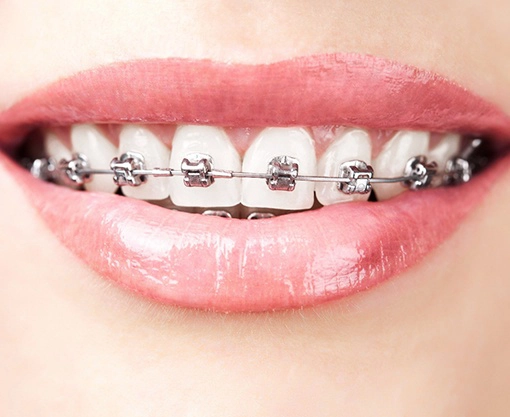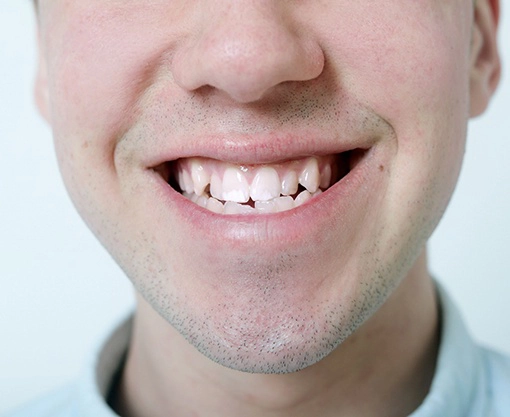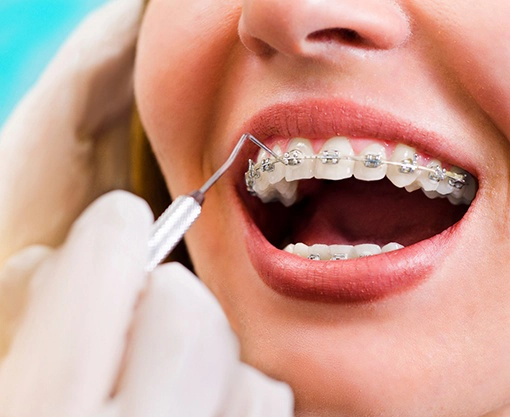Traditional Braces – Carmel, IN
A Tried-and-True Way to Straighter Teeth

When considering orthodontics, traditional braces are likely the first thing you picture. There’s a good reason for that – this treatment is the most popular and effective way to straighten teeth! Even now, after several decades, it continues to fix misaligned grins worldwide. As such, you can trust the braces from Springhetti Dentistry’s resident orthodontist, Dr. Oberley. She and her team will ensure your chompers look straighter than ever. To find out more, just keep reading or contact our office for details.
How Do Traditional Braces Work?

Left alone, teeth naturally shift over time. Their connection with tiny jaw ligaments means they’ll gradually move out of alignment. Should that happen, your smile and bite will turn crooked, looking unseemly and interfering with everyday tasks.
Traditional braces address these effects. By using a combination of brackets and wires, they apply gentle pressure to crooked teeth. The result is that they gradually push your chompers into a more aligned position.
The average braces treatment takes a year or two. Throughout that period, the dentist will adjust the archwire every six to eight weeks. The dental team may also need to add accessories – elastics, retainers, etc. – to assist with tooth movement.
What Orthodontic Issues Can Braces Fix?

As with any dental work, braces treatment starts with a consultation. This visit lets Dr. Oberley learn about your orthodontic issues, general oral health, and more. That way, she can see if you’re a good braces candidate.
The consult will review the problems treatment can solve if you qualify. These include:
Bite Misalignment
It may not seem serious, but bite misalignment causes severe problems. Without treatment, it may result in TMJ dysfunction, teeth grinding, and worse.
That said, braces could solve this obstacle. In putting pressure on teeth, they move jaw muscles into alignment. From there, your bite would be nice and even.
Crowded & Crooked Teeth
Besides looking bad, crooked teeth also harm your health. Due to rubbing against each other excessively, they wear down your enamel. The result is increased tooth sensitivity and a higher risk of tooth decay and infection.
Still, traditional braces represent a fine solution. They’d gently guide your smile so its teeth don’t overlap or rub excessively.
Gapped Teeth
Gaps between teeth aren’t just an eyesore; they lead to health issues, too. In particular, the spaces act as plaque traps that damage mouth tissues.
Braces, however, can correct tooth gaps. As the brackets and wires move your teeth, the spaces are eventually closed.
Caring for Your Braces

As excellent as they are, braces only work when given care. Therefore, you’ll need to clean and maintain them consistently. To that end, consider the following tips:
- Practice Good Oral Hygiene - Brush your teeth twice daily for two full minutes each session. Furthermore, don’t skip flossing; try flossers to make things easier.
- Avoid Risky Foods – Hard, crunchy, or chewy foods could break the archwire or dislodge the brackets.
- See Your Orthodontist Often – Remember to attend your orthodontic adjustment visits. Doing so lets our team assess your braces to ensure everything’s okay.
Understanding the Cost of Traditional Braces

Before undergoing treatment, you probably need to know how much it will cost. However, we will not provide a number here because each case is so unique. There isn’t a one-size-fits-all estimate we can give to everyone. Instead, when you come in for a consultation, we’ll closely examine your smile as it is currently and create a treatment plan designed specifically for you. At that point, we can talk about the numbers more accurately.
Factors That Affect the Cost of Traditional Braces
When calculating the cost of braces treatment, we take several things into account. The severity of your misalignment is one of the most important factors. The more complex and severe your misalignment, the higher the cost will be to fix it. Certain issues, such as under or cross bites, can require more extensive care, potentially increasing the cost. Also, the price will be impacted by how well you follow our instructions during your treatment. If you care for your braces properly, you’ll be more likely to stay within budget.
Professional Braces vs. "DIY" Braces: Which Costs More?
These days, people turn to YouTube for instructions on how to do anything and everything to avoid having to pay someone to do it for them, but when it comes to shifting teeth in your mouth, you shouldn’t try to handle it on your own. Many things can go wrong, and you could even end up losing teeth as a result. Your treatment should always be supervised and done by a highly trained professional who understands how to safely move teeth into proper alignment.
Does Dental Insurance Cover Braces?
In general, dental insurance plans include benefits for traditional braces—usually about half of the total cost. This can significantly reduce your price! Exact coverage may vary from plan to plan, but our front desk team can look at your policy and let you know how much it covers and how much you’ll need to pay out-of-pocket. First, however, you must meet with Dr. Springhetti or Dr. Oberley and have a treatment plan created to get a specific estimate.
Options for Making Braces Affordable
Whether you have insurance or not, at Springhetti Dentistry, we offer a couple ways to make the expense of traditional braces easier to take on. For those without dental insurance, our in-house membership plan may provide some savings. Along with preventive care, our membership plans come with a 10% discount on most services. If you would like to finance the amount you owe, we can help you apply for CareCredit, which breaks up the total cost into smaller monthly payments.
Traditional Braces FAQs
Am I Too Old to Get Braces?
If you missed your chance for braces as a teen or your teeth have shifted, you're never too old for braces. Age is just a number when investing in straight teeth. 1 in 5 orthodontic patients are over the age of 18 because of the diversity of treatments available. Your orthodontist will perform a visual examination and review diagnostic images of your mouth to create a personalized treatment plan. You must have healthy teeth and gums before getting braces. It's not unusual to need a little prep work, like gum disease therapy.
How Long Do Traditional Braces Take?
The average treatment using brackets and wires is about 18 to 24 months, but many factors affect the timeline. Age can play a role because teens are still growing and developing, so their teeth can move more quickly. The complexity of your alignment problems will also influence how long you'll need to wear braces. Complying with your treatment plan will ensure there aren't any delays in your journey. Your orthodontist will discuss exactly what you can expect on the road ahead.
Do Traditional Braces Cost More Than Invisalign?
Believe it or not, metal braces and Invisalign can cost about the same. There's no flat fee for either treatment because there's no cookie-cutter solution. The amount you'll pay is based on your treatment plan. We strive to keep a straight, healthy smile within everyone's budget, which is why we offer several financial solutions. Besides using your dental insurance to lower your out-of-pocket expenses, we also accept third-party financing. You can pay for your treatment using a monthly payment plan with little or no interest in financing based on your credit approval.
Can Traditional Braces Fix TMJ Dysfunction?
Many things can cause dysfunction of the temporomandibular joints, like a poor bite. If your upper and lower teeth do not rest on one another correctly, it can put pressure on your joints, which can result in inflammation. If a bad bite is the culprit behind your jaw pain, braces can provide the relief you need.
What Happens When Braces Come Off?
Once your braces come off, your treatment isn't over yet. You'll need to wear a retainer for a little while to prevent your teeth from moving back into their previous positions. A retainer allows your tissues to heal around your teeth to ensure your investments last.

